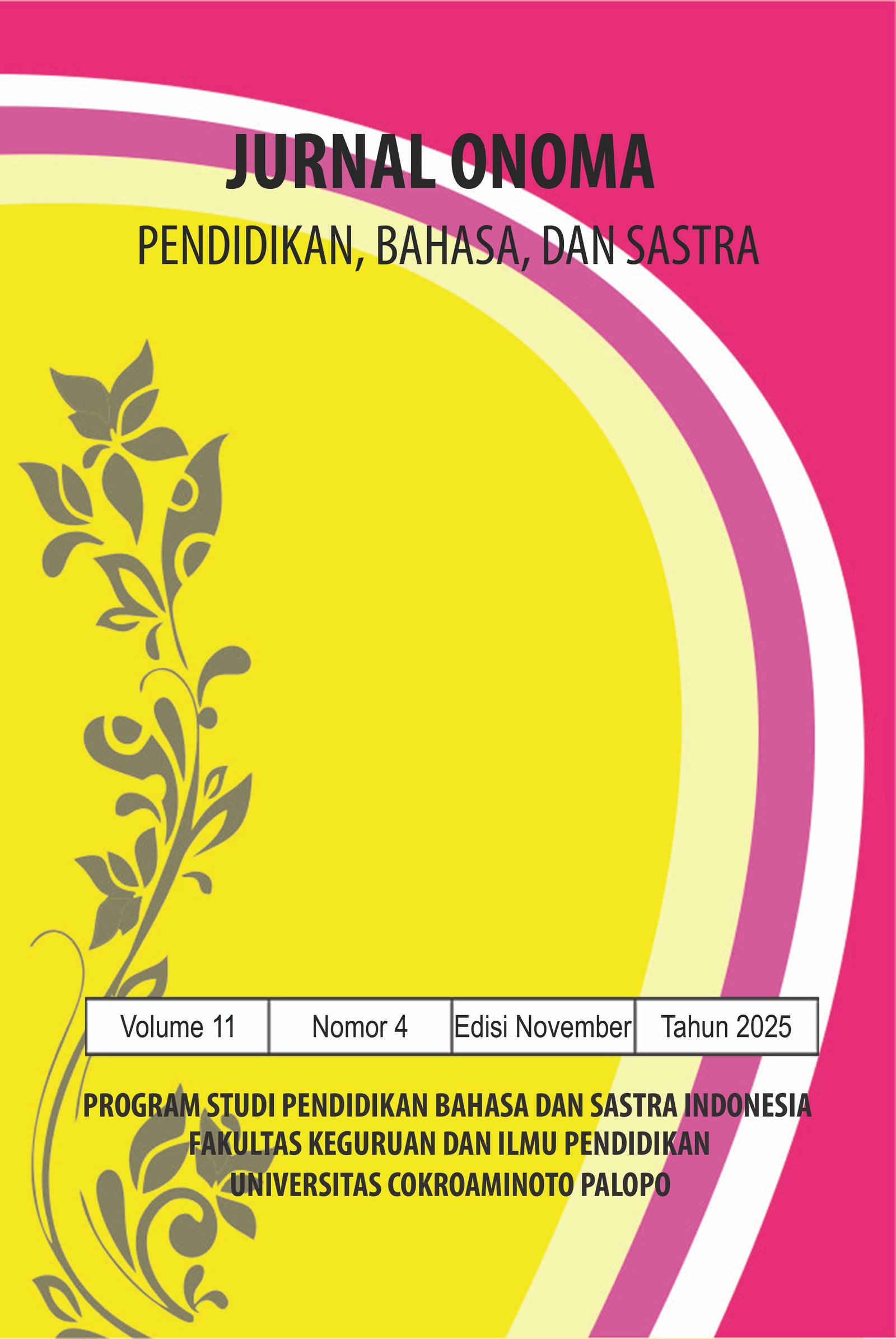Simbol dalam Tarian Cakalele pada Masyarakat Tobelo
https://doi.org/10.30605/onoma.v11i4.6808
Keywords:
simbol, budaya, cakaleleAbstract
Penelitian ini bertujuan untuk mengeksplorasi simbol-simbol dalam tarian Cakalele sebagai praktik komunikasi budaya masyarakat Tobelo di Maluku Utara. Menggunakan pendekatan kualitatif dan studi pustaka, penelitian ini menganalisis elemen-elemen simbolik tarian, termasuk gerak, kostum, properti (parang, salawaku, tombak), musik pengiring, serta formasi penari, sebagai tanda (sign) yang mengandung makna sosial, spiritual, dan filosofis. Hasil penelitian menunjukkan bahwa tarian Cakalele terdiri atas lima ragam gerak utama yang menyampaikan nilai keberanian, kehormatan, strategi perang, solidaritas, dan penghormatan terhadap leluhur. Musik pengiring, kostum, dan properti tari turut memperkuat komunikasi simbolik tersebut, membentuk sistem tanda budaya yang terpadu. Tarian ini bukan sekadar pertunjukan estetis, melainkan medium komunikasi non-verbal yang menegaskan identitas, norma, dan nilai kolektif masyarakat Tobelo. Penelitian ini memberikan kontribusi pada kajian linguistik antropologi dan studi simbol budaya dalam konteks seni tradisional, sekaligus mendokumentasikan makna simbolik yang hidup dalam tarian Cakalele.
Downloads
References
Abbas, I., Hasim, R., & Usman, S. H. (2021). Pelaksanaan Tari Cakalele di Desa Togawa Kecamatan Galela Selatan. Universitas Khairun.
Adam, R. (2022). Identitas budaya dalam ekspresi tarian Tobelo. Jurnal Seni dan Budaya Indonesia, 11(2), 135–150.
Arba, A., Salim, H., & Putra, T. (2023). The role of traditional music in cultural identity preservation: A case study of Maluku’s war dances. Journal of Indonesian Ethnomusicology, 9(1), 45–60.
Bakri, M. I., Sahetapy, F., & Kainama, R. (2020). Symbolic structures in the Cakalele war dance movements. Indonesian Journal of Cultural Studies, 15(2), 78–92.
Geertz, C. (1973). The interpretation of cultures: Selected essays. Basic Books.
Hymes, D. (1963). Introduction: Toward ethnographies of communication. American Anthropologist, 66(6), 1–34. DOI: https://doi.org/10.1525/aa.1964.66.suppl_3.02a00010
Koentjaraningrat. (2000). Pengantar ilmu antropologi. Rineka Cipta.
Saussure, F. de. (1988). Course in general linguistics (W. Baskin, Trans.). Open Court Publishing. (Original work published 1916)
Susilo, A., Wulandari, S., & Prasetyo, B. (2024). Aesthetic and spiritual values in Maluku’s traditional percussion instruments: A focus on the tifa. Asian Journal of Ethnomusicology, 12(1), 33–48
Suparman, S., & Charmilasari, C. (2017). Analysis of Phase Structure Realization in Classroom Discourse: A Study of Systemic Functional Linguistics. Ethical Lingua: Journal of Language Teaching and Literature, 4(2), 120-126. DOI: https://doi.org/10.30605/ethicallingua.v4i2.624
Tasarane, M., Rahman, S., & Latupono, E. (2022). Oral tradition and music transmission: The case of tifa rhythms in North Maluku. Journal of Southeast Asian Cultural Studies, 7(3), 112–128.
Downloads
Published
How to Cite
Issue
Section
Categories
License
Copyright (c) 2025 Rian Jamrud, Ivan Robert Bernadus Kaunang, Isty Wantasen

This work is licensed under a Creative Commons Attribution 4.0 International License.
In submitting the manuscript to the journal, the authors certify that:
- They are authorized by their co-authors to enter into these arrangements.
- The work described has not been formally published before, except in the form of an abstract or as part of a published lecture, review, thesis, or overlay journal.
- That it is not under consideration for publication elsewhere,
- That its publication has been approved by all the author(s) and by the responsible authorities – tacitly or explicitly – of the institutes where the work has been carried out.
- They secure the right to reproduce any material that has already been published or copyrighted elsewhere.
- They agree to the following license and copyright agreement.
License and Copyright Agreement
Authors who publish with Onoma Journal: Education, Languages??, and Literature agree to the following terms:
- Authors retain copyright and grant the journal right of first publication with the work simultaneously licensed under Creative Commons Attribution License (CC BY 4.0) that allows others to share the work with an acknowledgment of the work's authorship and initial publication in this journal.
- Authors are able to enter into separate, additional contractual arrangements for the non-exclusive distribution of the journal's published version of the work (e.g., post it to an institutional repository or publish it in a book), with an acknowledgment of its initial publication in this journal.
- Authors are permitted and encouraged to post their work online (e.g., in institutional repositories or on their website) prior to and during the submission process, as it can lead to productive exchanges, as well as earlier and greater citation of published work.

















